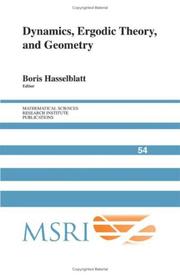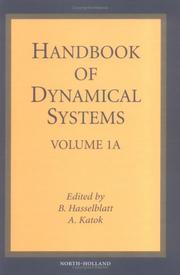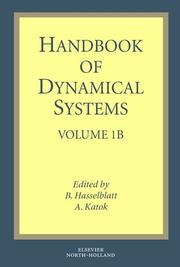| Listing 1 - 10 of 11 | << page >> |
Sort by
|
Book
ISBN: 3319430599 3319430580 Year: 2017 Publisher: Cham : Springer International Publishing : Imprint: Springer,
Abstract | Keywords | Export | Availability | Bookmark
 Loading...
Loading...Choose an application
- Reference Manager
- EndNote
- RefWorks (Direct export to RefWorks)
Focussing on the mathematics related to the recent proof of ergodicity of the (Weil–Petersson) geodesic flow on a nonpositively curved space whose points are negatively curved metrics on surfaces, this book provides a broad introduction to an important current area of research. It offers original textbook-level material suitable for introductory or advanced courses as well as deep insights into the state of the art of the field, making it useful as a reference and for self-study. The first chapters introduce hyperbolic dynamics, ergodic theory and geodesic and horocycle flows, and include an English translation of Hadamard's original proof of the Stable-Manifold Theorem. An outline of the strategy, motivation and context behind the ergodicity proof is followed by a careful exposition of it (using the Hopf argument) and of the pertinent context of Teichmüller theory. Finally, some complementary lectures describe the deep connections between geodesic flows in negative curvature and Diophantine approximation.
Mathematics. --- Dynamics. --- Ergodic theory. --- Differential geometry. --- Dynamical Systems and Ergodic Theory. --- Differential Geometry. --- Differential geometry --- Ergodic transformations --- Continuous groups --- Mathematical physics --- Measure theory --- Transformations (Mathematics) --- Dynamical systems --- Kinetics --- Mathematics --- Mechanics, Analytic --- Force and energy --- Mechanics --- Physics --- Statics --- Math --- Science --- Differentiable dynamical systems. --- Global differential geometry. --- Geometry, Differential --- Differential dynamical systems --- Dynamical systems, Differentiable --- Dynamics, Differentiable --- Differential equations --- Global analysis (Mathematics) --- Topological dynamics

ISBN: 9780511755187 9780521875417 9780521175418 9780511342851 0511342853 9780511341229 0511341229 0521875412 051175518X 1139883399 1281085413 9786611085414 1139132903 0511342322 0511341806 Year: 2007 Publisher: Cambridge New York Cambridge University Press
Abstract | Keywords | Export | Availability | Bookmark
 Loading...
Loading...Choose an application
- Reference Manager
- EndNote
- RefWorks (Direct export to RefWorks)
Based on the subjects from the Clay Mathematics Institute/Mathematical Sciences Research Institute Workshop titled 'Recent Progress in Dynamics' in September and October 2004, this volume contains surveys and research articles by leading experts in several areas of dynamical systems that have experienced substantial progress. One of the major surveys is on symplectic geometry, which is closely related to classical mechanics and an exciting addition to modern geometry. The survey on local rigidity of group actions gives a broad and up-to-date account of another flourishing subject. Other papers cover hyperbolic, parabolic, and symbolic dynamics as well as ergodic theory. Students and researchers in dynamical systems, geometry, and related areas will find this book fascinating. The book also includes a fifty-page commented problem list that takes the reader beyond the areas covered by the surveys, to inspire and guide further research.
Differentiable dynamical systems. --- Ergodic theory. --- Geometry. --- Mathematics --- Euclid's Elements --- Ergodic transformations --- Continuous groups --- Mathematical physics --- Measure theory --- Transformations (Mathematics) --- Differential dynamical systems --- Dynamical systems, Differentiable --- Dynamics, Differentiable --- Differential equations --- Global analysis (Mathematics) --- Topological dynamics

ISBN: 0521587506 0521583047 9780521583046 9780511998188 9780521587501 Year: 2003 Publisher: Cambridge Cambridge University Press
Abstract | Keywords | Export | Availability | Bookmark
 Loading...
Loading...Choose an application
- Reference Manager
- EndNote
- RefWorks (Direct export to RefWorks)
The theory of dynamical systems is a major mathematical discipline closely intertwined with all main areas of mathematics. It has greatly stimulated research in many sciences and given rise to the vast new area variously called applied dynamics, nonlinear science, or chaos theory. This introduction for senior undergraduate and beginning graduate students of mathematics, physics, and engineering combines mathematical rigor with copious examples of important applications. It covers the central topological and probabilistic notions in dynamics ranging from Newtonian mechanics to coding theory. Readers need not be familiar with manifolds or measure theory; the only prerequisite is a basic undergraduate analysis course. The authors begin by describing the wide array of scientific and mathematical questions that dynamics can address. They then use a progression of examples to present the concepts and tools for describing asymptotic behavior in dynamical systems, gradually increasing the level of complexity. The final chapters introduce modern developments and applications of dynamics. Subjects include contractions, logistic maps, equidistribution, symbolic dynamics, mechanics, hyperbolic dynamics, strange attractors, twist maps, and KAM-theory.
Differential geometry. Global analysis --- Differentiable dynamical systems. --- Dynamique différentiable --- 531.3 --- Dynamics. Kinetics --- 531.3 Dynamics. Kinetics --- Dynamique différentiable --- Differentiable dynamical systems --- Differential dynamical systems --- Dynamical systems, Differentiable --- Dynamics, Differentiable --- Differential equations --- Global analysis (Mathematics) --- Topological dynamics
Book
ISBN: 0521341876 9780521341875 9780511809187 9780521575577 0521575575 Year: 1995 Volume: 54 Publisher: Cambridge Cambridge University Press
Abstract | Keywords | Export | Availability | Bookmark
 Loading...
Loading...Choose an application
- Reference Manager
- EndNote
- RefWorks (Direct export to RefWorks)
This book provides the first self-contained comprehensive exposition of the theory of dynamical systems as a core mathematical discipline closely intertwined with most of the main areas of mathematics. The authors introduce and rigorously develop the theory while providing researchers interested in applications with fundamental tools and paradigms. The book begins with a discussion of several elementary but fundamental examples. These are used to formulate a program for the general study of asymptotic properties and to introduce the principal theoretical concepts and methods. The main theme of the second part of the book is the interplay between local analysis near individual orbits and the global complexity of the orbits structure. The third and fourth parts develop in depth the theories of low-dimensional dynamical systems and hyperbolic dynamical systems. The book is aimed at students and researchers in mathematics at all levels from advanced undergraduate up. Scientists and engineers working in applied dynamics, nonlinear science, and chaos will also find many fresh insights in this concrete and clear presentation. It contains more than four hundred systematic exercises.
Differentiable dynamical systems. --- Dynamique différentiable. --- 517.938 --- Theory of dynamic systems --- Dynamic systems --- 517.938 Theory of dynamic systems --- Differentiable dynamical systems --- Differential dynamical systems --- Dynamical systems, Differentiable --- Dynamics, Differentiable --- Differential equations --- Global analysis (Mathematics) --- Topological dynamics --- Differential geometry. Global analysis --- Dynamique différentiable --- Topological dynamics. --- Dynamique topologique. --- Systèmes dynamiques. --- Dynamique différentiable. --- Systèmes dynamiques.

ISBN: 1282878646 9786612878640 0080932266 0444531416 9780080932262 0080533442 9780080533445 1281034290 9781281034298 9780444826695 0444826696 9780444520555 0444520554 9780444501684 0444501681 9780444531414 9780444638212 0444638210 9786611034290 9786611038694 1281038695 0080532845 Year: 2002 Publisher: Amsterdam ; New York : North Holland : Elsevier,
Abstract | Keywords | Export | Availability | Bookmark
 Loading...
Loading...Choose an application
- Reference Manager
- EndNote
- RefWorks (Direct export to RefWorks)
Volumes 1A and 1B. These volumes give a comprehensive survey of dynamics written by specialists in the various subfields of dynamical systems. The presentation attains coherence through a major introductory survey by the editors that organizes the entire subject, and by ample cross-references between individual surveys. The volumes are a valuable resource for dynamicists seeking to acquaint themselves with other specialties in the field, and to mathematicians active in other branches of mathematics who wish to learn about contemporary ideas and results dynamics. Assuming only g
Differentiable dynamical systems. --- Differential dynamical systems --- Dynamical systems, Differentiable --- Dynamics, Differentiable --- Differential equations --- Global analysis (Mathematics) --- Topological dynamics --- 531.3 --- 531.3 Dynamics. Kinetics --- Dynamics. Kinetics --- Differentiable dynamical systems --- 517.988 --- 517.988 Nonlinear functional analysis and approximation methods --- Nonlinear functional analysis and approximation methods --- Bifurcation theory. --- Geometry --- Mathematics --- Physical Sciences & Mathematics

ISBN: 1281051047 9786611051044 0080478220 0444520554 Year: 2006 Publisher: Amsterdam : Elsevier,
Abstract | Keywords | Export | Availability | Bookmark
 Loading...
Loading...Choose an application
- Reference Manager
- EndNote
- RefWorks (Direct export to RefWorks)
This second half of Volume 1 of this Handbook follows Volume 1A, which was published in 2002. The contents of these two tightly integrated parts taken together come close to a realization of the program formulated in the introductory survey "Principal Structures? of Volume 1A.The present volume contains surveys on subjects in four areas of dynamical systems: Hyperbolic dynamics, parabolic dynamics, ergodic theory and infinite-dimensional dynamical systems (partial differential equations).. Written by experts in the field.. The coverage of ergodic theory in these two parts o
Digital
ISBN: 9780080932262 0080932266 0080533442 9780080533445 1281034290 9781281034298 Year: 2002 Publisher: New York Elsevier
Abstract | Keywords | Export | Availability | Bookmark
 Loading...
Loading...Choose an application
- Reference Manager
- EndNote
- RefWorks (Direct export to RefWorks)
This handbook is volume II in a series collecting mathematical state-of-the-art surveys in the field of dynamical systems. Much of this field has developed from interactions with other areas of science, and this volume shows how concepts of dynamical systems further the understanding of mathematical issues that arise in applications. Although modeling issues are addressed, the central theme is the mathematically rigorous investigation of the resulting differential equations and their dynamic behavior. However, the authors and editors have made an effort to ensure readability on a non-technical level for mathematicians from other fields and for other scientists and engineers. The eighteen surveys collected here do not aspire to encyclopedic completeness, but present selected paradigms. The surveys are grouped into those emphasizing finite-dimensional methods, numerics, topological methods, and partial differential equations. Application areas include the dynamics of neural networks, fluid flows, nonlinear optics, and many others. While the survey articles can be read independently, they deeply share recurrent themes from dynamical systems. Attractors, bifurcations, center manifolds, dimension reduction, ergodicity, homoclinicity, hyperbolicity, invariant and inertial manifolds, normal forms, recurrence, shift dynamics, stability, to name just a few, are ubiquitous dynamical concepts throughout the articles. This second half of Volume 1 of this Handbook follows Volume 1A, which was published in 2002. The contents of these two tightly integrated parts taken together come close to a realization of the program formulated in the introductory survey Principal Structures of Volume 1A. The present volume contains surveys on subjects in four areas of dynamical systems: Hyperbolic dynamics, parabolic dynamics, ergodic theory and infinite-dimensional dynamical systems (partial differential equations). . Written by experts in the field. . The coverage of ergodic theory in these two parts of Volume 1 is considerably more broad and thorough than that provided in other existing sources. . The final cluster of chapters discusses partial differential equations from the point of view of dynamical systems. Volumes 1A and 1B. These volumes give a comprehensive survey of dynamics written by specialists in the various subfields of dynamical systems. The presentation attains coherence through a major introductory survey by the editors that organizes the entire subject, and by ample cross-references between individual surveys. The volumes are a valuable resource for dynamicists seeking to acquaint themselves with other specialties in the field, and to mathematicians active in other branches of mathematics who wish to learn about contemporary ideas and results dynamics. Assuming only general mathematical knowledge the surveys lead the reader towards the current state of research in dynamics. Volume 1B will appear 2005. In this volume, the authors present a collection of surveys on various aspects of the theory of bifurcations of differentiable dynamical systems and related topics. By selecting these subjects, they focus on those developments from which research will be active in the coming years. The surveys are intended to educate the reader on the recent literature on the following subjects: transversality and generic properties like the various forms of the so-called Kupka-Smale theorem, the Closing Lemma and generic local bifurcations of functions (so-called catastrophe theory) and generic local bifurcations in 1-parameter families of dynamical systems, and notions of structural stability and moduli. Covers recent literature on various topics related to the theory of birfurcations of differentiable dynamical systems Highlights developments that are the foundation for future research in this field Provides material in the form of surveys which are important tools for introducing the birfucations of differentiable dynamical systems.
Book
ISBN: 1107266173 0511809182 Year: 1995 Publisher: Cambridge : Cambridge University Press,
Abstract | Keywords | Export | Availability | Bookmark
 Loading...
Loading...Choose an application
- Reference Manager
- EndNote
- RefWorks (Direct export to RefWorks)
This book provided the first self-contained comprehensive exposition of the theory of dynamical systems as a core mathematical discipline closely intertwined with most of the main areas of mathematics. The authors introduce and rigorously develop the theory while providing researchers interested in applications with fundamental tools and paradigms. The book begins with a discussion of several elementary but fundamental examples. These are used to formulate a program for the general study of asymptotic properties and to introduce the principal theoretical concepts and methods. The main theme of the second part of the book is the interplay between local analysis near individual orbits and the global complexity of the orbit structure. The third and fourth parts develop the theories of low-dimensional dynamical systems and hyperbolic dynamical systems in depth. Over 400 systematic exercises are included in the text. The book is aimed at students and researchers in mathematics at all levels from advanced undergraduate up.
Book
ISBN: 1316037363 051199818X Year: 2003 Publisher: Cambridge : Cambridge University Press,
Abstract | Keywords | Export | Availability | Bookmark
 Loading...
Loading...Choose an application
- Reference Manager
- EndNote
- RefWorks (Direct export to RefWorks)
The theory of dynamical systems is a major mathematical discipline closely intertwined with all main areas of mathematics. It has greatly stimulated research in many sciences and given rise to the vast new area variously called applied dynamics, nonlinear science, or chaos theory. This introduction for senior undergraduate and beginning graduate students of mathematics, physics, and engineering combines mathematical rigor with copious examples of important applications. It covers the central topological and probabilistic notions in dynamics ranging from Newtonian mechanics to coding theory. Readers need not be familiar with manifolds or measure theory; the only prerequisite is a basic undergraduate analysis course. The authors begin by describing the wide array of scientific and mathematical questions that dynamics can address. They then use a progression of examples to present the concepts and tools for describing asymptotic behavior in dynamical systems, gradually increasing the level of complexity. The final chapters introduce modern developments and applications of dynamics. Subjects include contractions, logistic maps, equidistribution, symbolic dynamics, mechanics, hyperbolic dynamics, strange attractors, twist maps, and KAM-theory.

ISBN: 9780521840736 0521840732 Year: 2004 Publisher: Cambridge: Cambridge university press,
Abstract | Keywords | Export | Availability | Bookmark
 Loading...
Loading...Choose an application
- Reference Manager
- EndNote
- RefWorks (Direct export to RefWorks)
| Listing 1 - 10 of 11 | << page >> |
Sort by
|

 Search
Search Feedback
Feedback About UniCat
About UniCat  Help
Help News
News